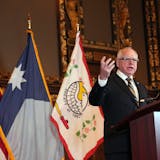Dianna Johnson's mother was 76 years old when she took out her first payday loan. She couldn't pay off the roughly $200 debt, so she borrowed another. And another.
"It's a vicious cycle," said Johnson, who helped her mom repay the loan after watching her spend a year returning to the Payday America in Coon Rapids.
Around 25,000 Minnesotans leaned on payday lenders in 2022, on average racking up six loans with annual percentage rates of around 210%, according to Minnesota Department of Commerce data. That practice is ending, and with it a "debt trap" opponents said has sucked low-income borrowers into a cycle that's difficult to escape.
Minnesota has joined 19 other states that have restricted payday loans, which are generally small amounts of cash — often a few hundred dollars — meant for borrowers to pay off in a couple weeks. The state capped annual percentage rates in most cases at 36% starting Jan. 1, 2024, though lenders could go up to 50% if they follow strict rules to ensure the borrower can repay the sum.
Minnesota's biggest lender, Payday America, stopped offering the loans shortly after the law was passed this spring.
Payday lenders have largely disappeared in other states that added such interest rate restrictions, said Yasmin Farahi, deputy director of state policy and senior policy counsel at the Center for Responsible Lending.
"How payday lenders succeed is making sure their customers fail," Farahi said.
She said a recent study by the center found payday loans sapped roughly $4.5 million in fees from Minnesotans in a year.



